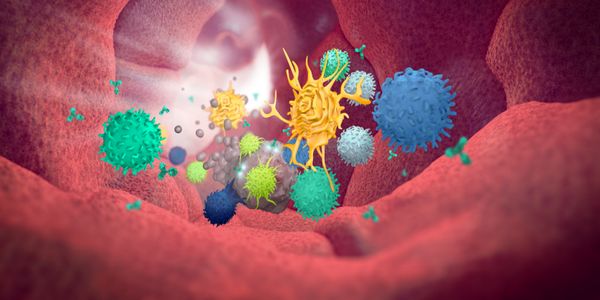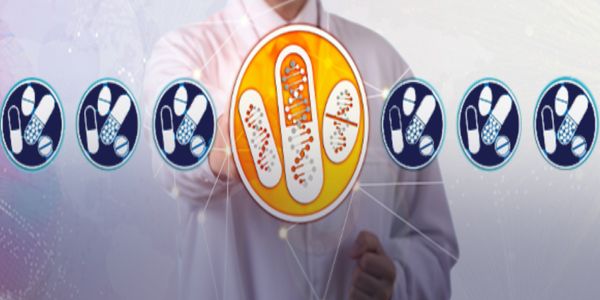Genomics
Genomics: an interdisciplinary field of science within the field of molecular biology. A genome is a complete set of DNA within a single cell of an organism, and as such, focuses on the structure, function, evolution, and mapping of genomes. Genomics aims at the collective characterization and quantification of genes, which direct the production of proteins with the assistance of enzymes and messenger molecules. Genomics also involves the sequencing and analysis of genomes.
-
SEP 17, 2020 | 3:30 PMRichard Hughes: New immunogenicity strategies to meet the needs of a developing pandemic Shortly after the COVID-19 pandemic began, the subject of serological testing for anti-viral antibodi...Speaker: Russell Garlick, PhD , Richard Hughes , Joel Lefferts, PhD, HCLD, DABCCSEP 17, 2020 | 12:00 PMNext-generation sequencing (NGS) is the primary technology used to identify genomic targets for vaccine development, detect emerging viral strains and monitor transmission patterns. Enhanced...SEP 17, 2020 | 11:00 AMIn less than nine months, the Severe Acute Respiratory Syndrome Coronavirus 2 (SARS-CoV-2) has killed hundreds of thousands of people, including >23,000 in New York City (NYC) alone. The...SEP 17, 2020 | 1:30 PMThe Allen Institute for Cell Science is generating a state space of stem cell signatures. The goal is to understand cell organization, identify cell states, and elucidate how cells transitio...SEP 17, 2020 | 10:00 AMLearning Objectives: 1. Drug Repurposing Strategies for SARS-CoV2 2. Validation pipeline for SARS-CoV-2 antiviral 3. Outlook for SARS-CoV-2 therapeutics...SEP 17, 2020 | 12:00 AMAs the spread of infectious diseases, current pandemic, and growing antimicrobial resistance (AMR) continues globally, next-generation sequencing (NGS) became a tool to diagnose infectious d...SEP 16, 2020 | 12:45 PMThe inner nuclear membrane of eukaryotic cells defines many aspects of gene expression and chromatin organization. It is also therapeutically important as several diseases, termed “lam...SEP 16, 2020 | 9:00 AMDate: September 16, 2020 Time: 9:00am PTD, 12:00pm EDT Harnessing the power of the host immune system to treat diseases has been transformational in patient care. Physiologically relevant ce...SEP 11, 2020 | 8:00 AMDATE: September 11, 2020 TIME: 08:00am PT, 11:00pm ET This is the third topic in the webinar series on ‘ Predictive Genomics for Population & Personalized Health ’. Pharmacog...SEP 10, 2020 | 12:00 PMIn this webinar, we will present QIAGEN CLC Genomics Workbench and its utility for bacterial isolate identification, strain discrimination using core genome multi-locus typing (cgMLST) and d...Speaker: Jonathan Jacobs, PhDSEP 10, 2020 | 11:00 AMLearning Objectives: 1. Understand the challenges of extracting DNA from human samples for microbiome analysis, and learn about the best technologies for accomplishing this 2. Learn about pr...Speaker: Dominic O'Neil, MS, MBASEP 10, 2020 | 10:00 AMEnigmatic and often vilified, viruses are now known to play important and possibly indispensable roles in the biology and ecology of cellular organisms. Evidence of viral impacts are everywh...SEP 10, 2020 | 12:00 AMThe transfer of antimicrobial resistance genes (ARG) to pathogenic microbes is a major concern in modern medicine. Antibiotic therapies are often rendered ineffective by horizontal acquisiti...SEP 10, 2020 | 12:00 AMSepsis is a life-threatening condition that is caused by the immune system’s inability to respond appropriately to an infection. How sepsis can change the gut microbiome in ways that a...SEP 10, 2020 | 12:00 AMLessons around leveraging high-complexity next-generation sequencing tests for precision infectious disease discovery to guide patient treatment and improve health outcomes. Learning Objecti...SEP 09, 2020 | 9:00 AMEpidemics are occurring at an increasing pace and scale. Our laboratory group has developed platform technologies for discovery of broad and potent neutralizing antibodies for many emerging...SEP 09, 2020 | 7:30 AMHIV currently infects almost 40 million people worldwide. The virus is responsible for ~2 million new infections per year and ~1 million deaths. Like all retroviruses, HIV integrates a viral...Speaker: Dmitry Lyumkis, PhDSEP 09, 2020 | 6:00 AMMy group is addressing fundamental questions in evolutionary biology, using both genome- and phenotype-first approaches. A few years ago, we discovered that Arabidopsis thaliana is a great m...Speaker: Detlef Weigel, Executive DirectorPresented at: Microbiology Week Virtual Event Series 2020
SEP 09, 2020 | 12:00 AMThe regions of our genome responsible for encoding the genes that regulate our immune response are some of the most complex and polymorphic known. This complexity encompasses multiple types...SEP 09, 2020 | 12:00 AMTo establish productive infection, plant viruses need to be able to efficiently invade and spread within a plant. Most viruses are introduced into a plant via the epidermal or mesophyll cell...SEP 09, 2020 | 12:00 AMProkaryotic DNA contains three types of methylation: N6-methyladenine, N4-methylcytosine and 5-methylcytosine. The lack of tools to analyse the frequency and distribution of methylated resid...SEP 09, 2020 | 12:00 AMHuman chromosome 19q13.4 contains genes encoding killer-cell immunoglobulin-like receptors (KIR). The region has certain properties such as single nucleotide variation, structural variation,...SEP 08, 2020 | 11:00 PMThe recent outbreak of SARS-CoV-2 underscores the need for understanding the evolutionary processes that drive the emergence and adaptation of zoonotic viruses in humans. Here, we show that...SEP 08, 2020 | 11:00 PMBackground: Haemophilus influenzae is the causative agent of multiple human disease conditions among multiple sites in the human body. Underlying genetic mechanisms are elusive, particularly...
SEP 17, 2020 | 3:30 PM
Richard Hughes: New immunogenicity strategies to meet the needs of a developing pandemic Shortly after the COVID-19 pandemic began, the subject of serological testing for anti-viral antibodi...
Speaker:
Russell Garlick, PhD
, Richard Hughes
, Joel Lefferts, PhD, HCLD, DABCC
SEP 17, 2020 | 12:00 PM
Next-generation sequencing (NGS) is the primary technology used to identify genomic targets for vaccine development, detect emerging viral strains and monitor transmission patterns. Enhanced...
SEP 17, 2020 | 11:00 AM
In less than nine months, the Severe Acute Respiratory Syndrome Coronavirus 2 (SARS-CoV-2) has killed hundreds of thousands of people, including >23,000 in New York City (NYC) alone. The...
SEP 17, 2020 | 1:30 PM
The Allen Institute for Cell Science is generating a state space of stem cell signatures. The goal is to understand cell organization, identify cell states, and elucidate how cells transitio...
SEP 17, 2020 | 10:00 AM
Learning Objectives: 1. Drug Repurposing Strategies for SARS-CoV2 2. Validation pipeline for SARS-CoV-2 antiviral 3. Outlook for SARS-CoV-2 therapeutics...
SEP 17, 2020 | 12:00 AM
As the spread of infectious diseases, current pandemic, and growing antimicrobial resistance (AMR) continues globally, next-generation sequencing (NGS) became a tool to diagnose infectious d...
SEP 16, 2020 | 12:45 PM
The inner nuclear membrane of eukaryotic cells defines many aspects of gene expression and chromatin organization. It is also therapeutically important as several diseases, termed “lam...
SEP 16, 2020 | 9:00 AM
Date: September 16, 2020 Time: 9:00am PTD, 12:00pm EDT Harnessing the power of the host immune system to treat diseases has been transformational in patient care. Physiologically relevant ce...
SEP 11, 2020 | 8:00 AM
DATE: September 11, 2020 TIME: 08:00am PT, 11:00pm ET This is the third topic in the webinar series on ‘ Predictive Genomics for Population & Personalized Health ’. Pharmacog...
SEP 10, 2020 | 12:00 PM
In this webinar, we will present QIAGEN CLC Genomics Workbench and its utility for bacterial isolate identification, strain discrimination using core genome multi-locus typing (cgMLST) and d...
Speaker:
Jonathan Jacobs, PhD
SEP 10, 2020 | 11:00 AM
Learning Objectives: 1. Understand the challenges of extracting DNA from human samples for microbiome analysis, and learn about the best technologies for accomplishing this 2. Learn about pr...
Speaker:
Dominic O'Neil, MS, MBA
SEP 10, 2020 | 10:00 AM
Enigmatic and often vilified, viruses are now known to play important and possibly indispensable roles in the biology and ecology of cellular organisms. Evidence of viral impacts are everywh...
SEP 10, 2020 | 12:00 AM
The transfer of antimicrobial resistance genes (ARG) to pathogenic microbes is a major concern in modern medicine. Antibiotic therapies are often rendered ineffective by horizontal acquisiti...
SEP 10, 2020 | 12:00 AM
Sepsis is a life-threatening condition that is caused by the immune system’s inability to respond appropriately to an infection. How sepsis can change the gut microbiome in ways that a...
SEP 10, 2020 | 12:00 AM
Lessons around leveraging high-complexity next-generation sequencing tests for precision infectious disease discovery to guide patient treatment and improve health outcomes. Learning Objecti...
SEP 09, 2020 | 9:00 AM
Epidemics are occurring at an increasing pace and scale. Our laboratory group has developed platform technologies for discovery of broad and potent neutralizing antibodies for many emerging...
SEP 09, 2020 | 7:30 AM
HIV currently infects almost 40 million people worldwide. The virus is responsible for ~2 million new infections per year and ~1 million deaths. Like all retroviruses, HIV integrates a viral...
Speaker:
Dmitry Lyumkis, PhD
SEP 09, 2020 | 6:00 AM
My group is addressing fundamental questions in evolutionary biology, using both genome- and phenotype-first approaches. A few years ago, we discovered that Arabidopsis thaliana is a great m...
Speaker:
Detlef Weigel, Executive Director
Presented at: Microbiology Week Virtual Event Series 2020
SEP 09, 2020 | 12:00 AM
The regions of our genome responsible for encoding the genes that regulate our immune response are some of the most complex and polymorphic known. This complexity encompasses multiple types...
SEP 09, 2020 | 12:00 AM
To establish productive infection, plant viruses need to be able to efficiently invade and spread within a plant. Most viruses are introduced into a plant via the epidermal or mesophyll cell...
SEP 09, 2020 | 12:00 AM
Prokaryotic DNA contains three types of methylation: N6-methyladenine, N4-methylcytosine and 5-methylcytosine. The lack of tools to analyse the frequency and distribution of methylated resid...
SEP 09, 2020 | 12:00 AM
Human chromosome 19q13.4 contains genes encoding killer-cell immunoglobulin-like receptors (KIR). The region has certain properties such as single nucleotide variation, structural variation,...
SEP 08, 2020 | 11:00 PM
The recent outbreak of SARS-CoV-2 underscores the need for understanding the evolutionary processes that drive the emergence and adaptation of zoonotic viruses in humans. Here, we show that...
SEP 08, 2020 | 11:00 PM
Background: Haemophilus influenzae is the causative agent of multiple human disease conditions among multiple sites in the human body. Underlying genetic mechanisms are elusive, particularly...
























